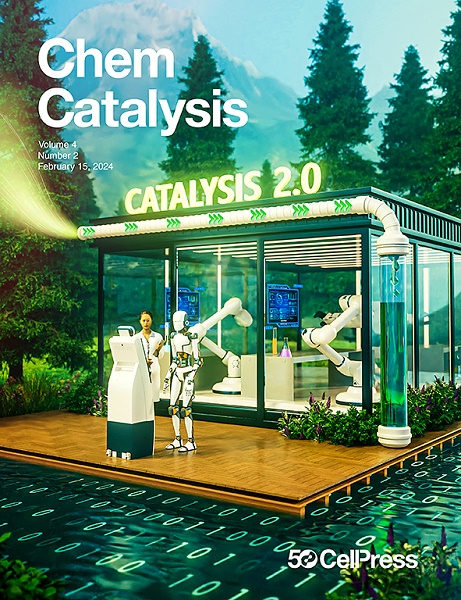纳米级热管理增强了甲烷与二氧化碳的光热干重整
IF 11.6
Q1 CHEMISTRY, PHYSICAL
引用次数: 0
摘要
甲烷和二氧化碳通过干重整催化转化在技术和学术上都是至关重要的,因为它完全从温室气体排放中产生合成气。鉴于这是一个能源密集型吸热过程,光热催化的集成对于减少或替代化石能源输入至关重要。不同包封策略影响的纳米级催化剂内部传热对整体催化效率起着关键作用。为此,将镍基催化剂嵌入隔热的TS-1沸石基体中,产生不同的热环境。TS-1分子筛限制了镍颗粒的生长,调节了内能,在450℃下,单次光热CO2转化率达到53.6%,超过热力学平衡极限300%。在超过300小时的测试中,它还表现出优异的稳定性,H2与CO的化学计量比接近理想的1:1。本文章由计算机程序翻译,如有差异,请以英文原文为准。

Nanoscale heat management enhanced photothermal methane dry reforming with carbon dioxide
Methane and carbon dioxide catalytic conversion through dry reforming is crucial both technically and academically because it generates syngas solely from greenhouse gas emissions. Given that this is an energy-intensive endothermic process, the integration of photothermal catalysis is essential for reducing or replacing fossil energy input. Nanoscale heat transfer within catalysts influenced by various encapsulation strategies plays a key role in overall catalytic efficiency. In this regard, different thermal environments are generated using nickel-based catalysts embedded in the thermally insulating TS-1 zeolite matrix. TS-1 zeolite limits the growth of nickel particles and regulates internal energy, achieving a remarkable photothermal CO2 conversion rate of 53.6% in a single pass at 450°C, exceeding the thermodynamic equilibrium limit by 300%. It also demonstrates excellent stability over more than 300 h of testing, with a near-ideal 1:1 stoichiometric ratio of H2 to CO.
求助全文
通过发布文献求助,成功后即可免费获取论文全文。
去求助
来源期刊
CiteScore
10.50
自引率
6.40%
发文量
0
期刊介绍:
Chem Catalysis is a monthly journal that publishes innovative research on fundamental and applied catalysis, providing a platform for researchers across chemistry, chemical engineering, and related fields. It serves as a premier resource for scientists and engineers in academia and industry, covering heterogeneous, homogeneous, and biocatalysis. Emphasizing transformative methods and technologies, the journal aims to advance understanding, introduce novel catalysts, and connect fundamental insights to real-world applications for societal benefit.

 求助内容:
求助内容: 应助结果提醒方式:
应助结果提醒方式:


